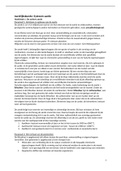Class notes
Answers to homework questions - Incentives & Control (6314M0401Y)
- Course
- Institution
This document contains my answers to the homework questions of the course 'Incentives and Control' (6314M0401Y) at the university of Amsterdam. The answers are amended with my notes from the tutorials. This course was taught by Peter Kroos as part of the master Accountancy and Control in 2024.
[Show more]









